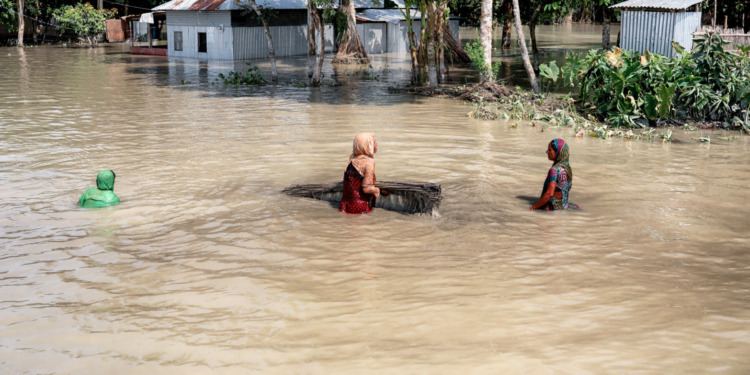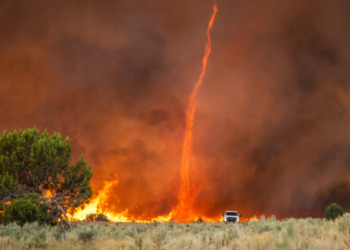Climate change is disproportionately affecting the incomes of rural women, people living in poverty, and older populations, as their capacity to react and adapt to extreme weather events is unequal, a new report from the Food and Agriculture Organization of the United Nations (FAO) finds.
The Unjust Climate report highlights a stark reality: each year in low and middle-income countries (LMICs), female heads of households in rural areas suffer significantly greater financial losses than men. On average, female-headed households lose 8% more of their income due to heat stress and 3% more due to floods compared to male-headed households. This translates to a per capita reduction of $83 due to heat stress and $35 due to floods, totalling $37 billion and $16 billion respectively across all LMICs.
If the average temperatures were to increase by just 1°C, these women would face a staggering 34% greater loss in their total incomes compared to men. Considering the significant existing differences in agricultural productivity and wages between women and men, the study suggests that if not addressed, climate change will greatly widen these gaps in the years ahead.
FAO analyzed socioeconomic data from over 100,000 rural households (representing more than 950 million people) across 24 LMICs. By integrating this information with 70 years of georeferenced daily precipitation and temperature data, the report examines how various climate stressors impact people’s incomes, labour, and adaptation strategies, differentiating based on their wealth, gender, and age.
Impacts differ not just by gender but by socioeconomic status, according to the data. Heat stress, or overexposure to high temperatures, exacerbates the income disparity between rural households classified as poor, who suffer a 5% greater loss ($17 per capita) than their better-off neighbours, and the figures for flooding are similar. Extreme temperatures, meanwhile, worsen child labour and increase the unpaid workload for women in poor households.
‘’Social differences based on locations, wealth, gender and age have a powerful, yet poorly understood, impact on rural peoples’ vulnerability to the impacts of the climate crisis. These findings highlight the urgent need to dedicate substantially more financial resources and policy attention to issues of inclusivity and resilience in global and national climate actions,” said FAO Director-General QU Dongyu.
Indeed, barriers such as access to resources, services and employment opportunities affect rural people’s capacity to adapt to and cope with climate change. For example, discriminatory norms and policies place a disproportionate burden on women for care and domestic responsibilities, limit their rights to land, prevent them from making decisions over their labour and hamper their access to information, finance, technology and other essential services.
Similarly, households led by young individuals have an easier time finding off-farm job opportunities during extreme weather conditions compared to older households. This makes their incomes less susceptible to these events.
Extreme weather also compels impoverished rural households to resort to maladaptive coping strategies. These may include reducing income streams, selling off livestock, and shifting spending away from their farms. These actions, however, exacerbate their vulnerability to long-term climate changes.
Taking action
The report suggests that addressing these challenges requires targeted interventions to empower various rural populations to engage in climate-adaptive measures.
The study finds rural people and their climate vulnerabilities are barely visible in national climate plans. In the nationally determined contributions (NDCs) and national adaptation plans (NAPs) of the 24 countries analysed in the report, only 6% of the 4,164 climate actions proposed mention women, 2% explicitly mention youths, less than 1% mention poor people and about 6% refer to farmers in rural communities.
Similarly, of the total tracked climate finance in 2017/18, only 7.5% went towards climate change adaptation; less than 3% to agriculture, forestry and other land uses, or other agriculture-related investments; only 1.7%, amounting to roughly $10 billion, reached small-scale producers.
Agricultural policies also miss the opportunity to address gender equality and women’s empowerment and intersecting vulnerabilities such as climate change. An analysis of agricultural policies from 68 low- and middle-income countries done by FAO last year showed that about 80% of policies did not consider women and climate change.
Related Articles: How Does Climate Change Affect Agriculture? | Connections That Matter: Climate Change and Gender Equality | Gender Equality: The Foundation for Achieving the Global Goals
Among several policy highlights, the report calls for investing in policies and programmes that address the multidimensional climate vulnerabilities of rural people and their specific constraints, including their limited access to productive resources. It also recommends linking social protection programmes to advisory services that can encourage adaptation and compensate farmers for losers, such as cash-based social assistance programs.
Gender-transformative methodologies that directly challenge discriminatory gender norms, could also tackle the entrenched discrimination that often prevents women from exercising full agency over economic decisions that impact their lives.
Inclusive climate actions are embedded in FAO’s Strategy and Action Plan on Climate Change and in the FAO Strategic Framework 2022–2031, where tackling the impact of climate change is mainstreamed in efforts to achieve the four betters: better production, better nutrition, better environment and better life for all.
Similarly, FAO’s Global Roadmap for Achieving SDG 2 without breaching the 1.5 °C threshold, establishes that gender inequalities, climate actions and nutrition are simultaneous considerations, and actions must encompass these dimensions and promote inclusivity for women, youth and Indigenous Peoples.
Other key report findings
- In an average year, poor households lose 4.4% of their total income due to floods relative to better-off households.
- Rising temperatures increase poor households’ dependency on climate-sensitive agriculture relative to that of non-poor households. A 1° C increase in average temperatures leads to a 53% increase in the farm incomes of poor households and a 33% decrease in their off-farm incomes, relative to non-poor households.
- Women plot managers are as capable as men to adopt climate-adaptive agricultural practices, but often lose more income and off-farm opportunities when exposed to extreme weather events. Each day of extreme high temperature reduces the total value of crops produced by women farmers by 3% relative to men.
- In an average year, households headed by young people see their total incomes increase by 3% due to floods, and by 6% because of heat stress, relative to older households.
- Heat stresses cause young rural households in low- and middle-income countries to increase their annual off-farm income by $47 billion relative to that of other households.
- Extreme temperatures push children to increase their weekly working time by 49 minutes relative to prime-aged adults, mostly in the off-farm sector, closely mirroring the increase in the work burden of women.
Editor’s Note: The opinions expressed here by the authors are their own, not those of Impakter.com — In the Featured Photo: During this recent flood in Bangladesh, women, children and less mobile people are the worst victim. Many women with children had to live under the sky, later they have found shelter. About five million people affected by the flood. Featured Photo Credit: UN Women.










